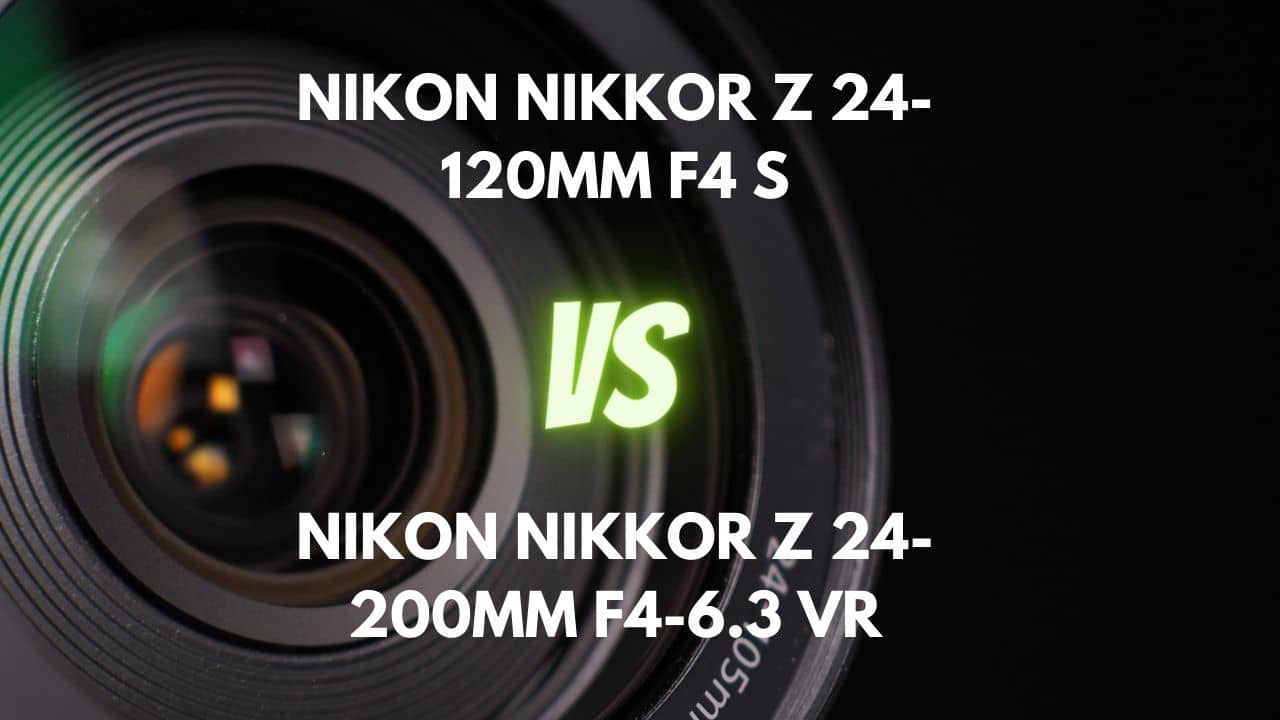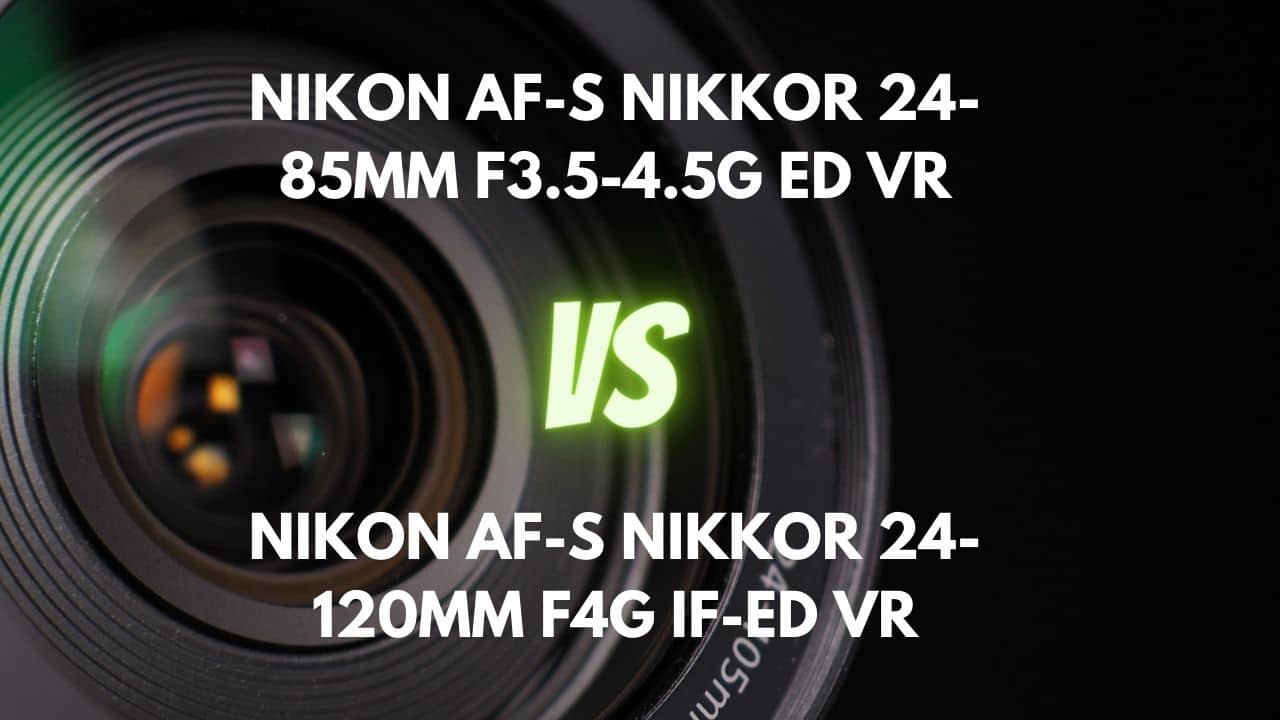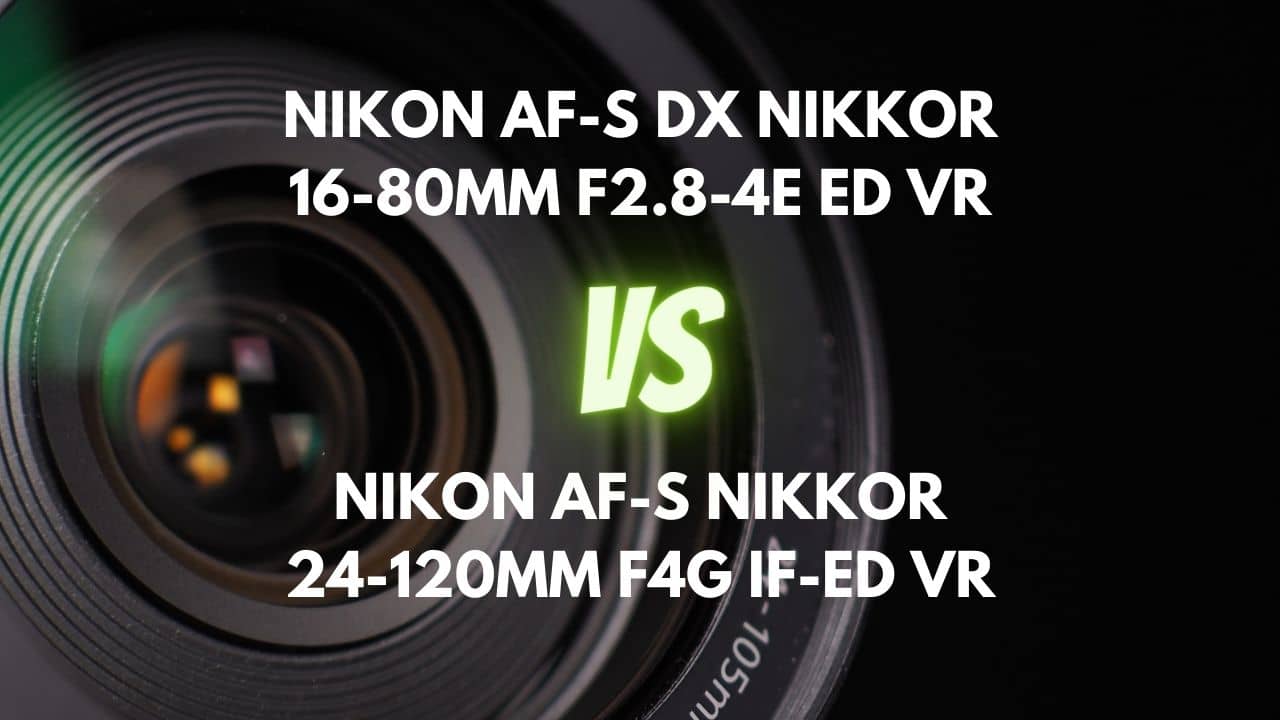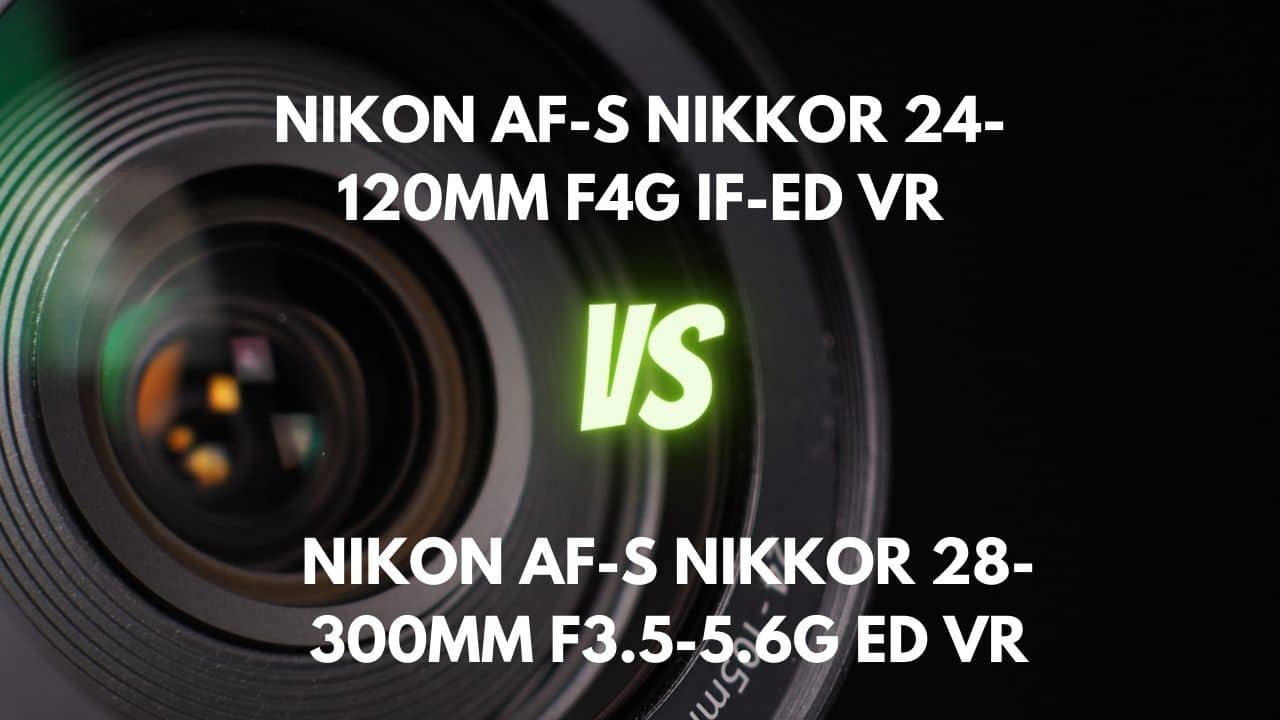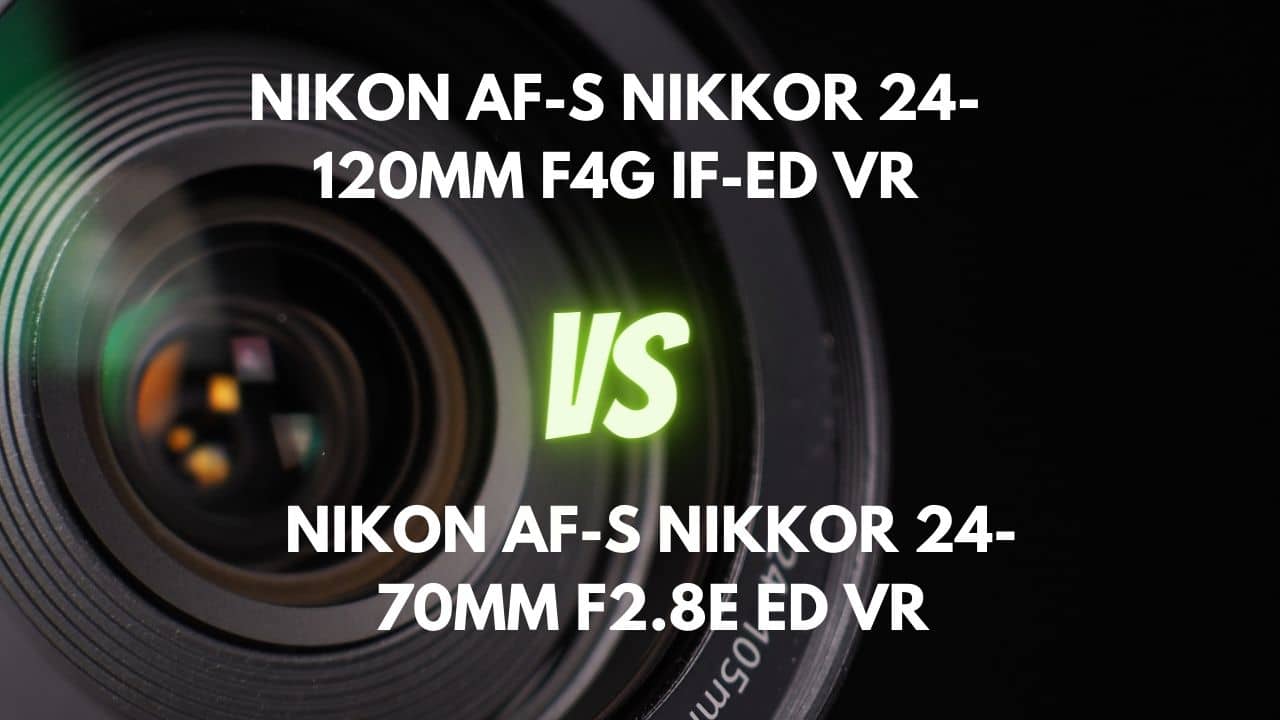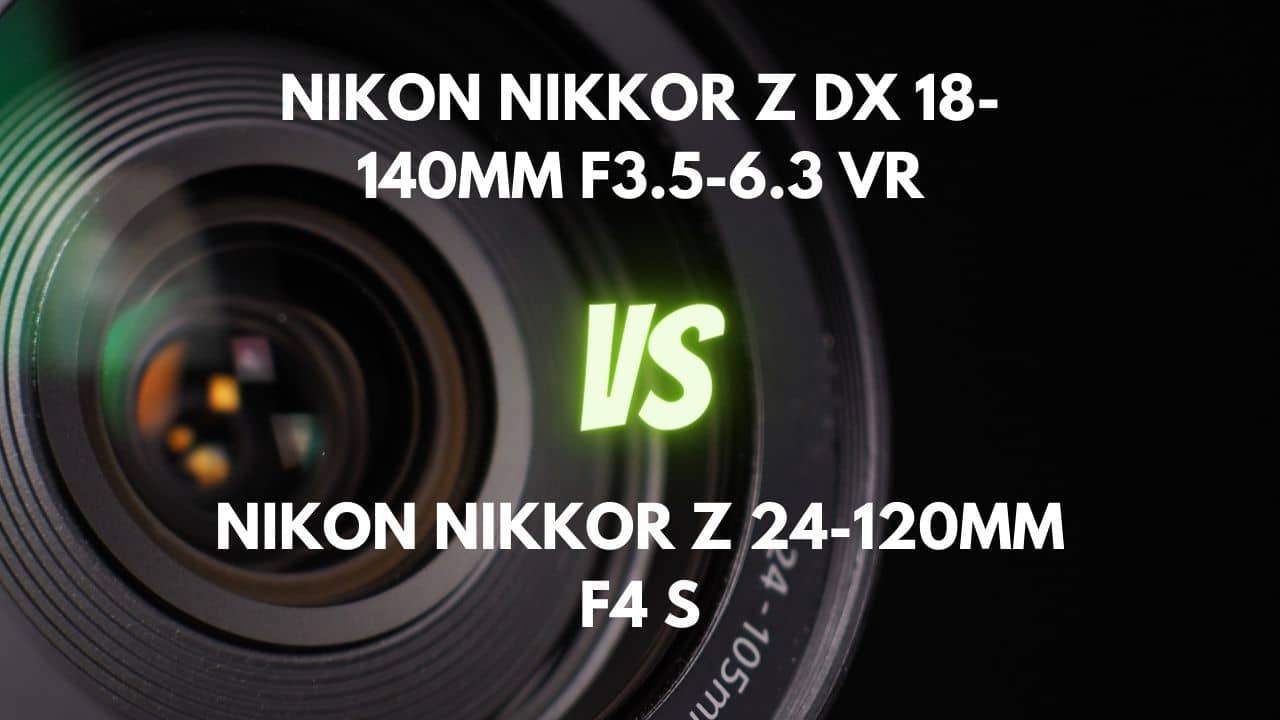As the highly anticipated APS-C cameras makes their entrance into the market, photographers are left pondering their lens choices for these powerful DX-format cameras.
For those accustomed to the exceptional performance of Nikon’s 24-70mm f/2.8 lens on full-frame cameras like the D750, the lens’s focal range may not be as fitting when used with a DX body. Enter the Nikon 16-80mm f/2.8-4 lens, designed to provide an equivalent 24-120mm focal range, which could potentially bridge the gap for photographers seeking a versatile zoom lens for their DX-format cameras.
In this article, we will dive into an in-depth comparison of these two lenses, evaluating their quality, performance.
Join us as we explore the possibilities and help you make an informed decision, ensuring you won’t have to compromise on image quality or versatility as you embrace the new era of DX photography.
Overview
| Nikon AF-S DX NIKKOR 16-80mm F2.8-4E ED VR | Nikon AF-S NIKKOR 24-70mm F2.8E ED VR | |
|---|---|---|
| Max Aperture | F2.8-4.0 | F2.8 |
| Aperture Type | Variable | Fixed |
| Focal Range (mm) | 16-80 | 24-70 |
| Max Format | APS-C / DX | 35mm FF |
| Zoom Ratio (X) | 5 | 2.9 |
Comparing the Nikon DX 16-80mm f/2.8-4 and the Nikon FX 24-70mm f/2.8, both lenses have their unique strengths and weaknesses. The 16-80mm lens offers a 5x zoom ratio and a variable aperture of f/2.8-4.0, while the 24-70mm lens has a 2.9x zoom ratio and a fixed aperture of f/2.8. The 16-80mm lens is designed for APS-C / DX format cameras, while the 24-70mm lens is suitable for 35mm full-frame cameras.
The 16-80mm lens, with its 35mm equivalent focal length of 24-120mm, provides a broader focal range, making it more versatile for various shooting scenarios. However, its variable aperture (f/4.2-6 for 35mm equivalent) can lead to reduced low light performance and less consistent image quality across the zoom range compared to the 24-70mm lens. This lens might be more appealing to photographers who prioritize versatility in focal lengths and shoot mainly in well-lit environments.
On the other hand, the 24-70mm lens offers better low light performance due to its wider fixed aperture of f/2.8. This lens is likely to deliver more consistent image quality across the entire zoom range, making it an excellent choice for photographers who need better low light performance and consistent image quality. However, its narrower focal range and compatibility with full-frame cameras might make it less versatile for some users.
In conclusion, neither lens is definitively superior, as the choice depends on individual needs and preferences. The 16-80mm lens offers more versatility in terms of focal range, while the 24-70mm lens delivers better low light performance and more consistent image quality across its zoom range. Photographers should consider their specific requirements and intended use when deciding between these two lenses.
Design and Ease of Use
| Nikon AF-S DX NIKKOR 16-80mm F2.8-4E ED VR | Nikon AF-S NIKKOR 24-70mm F2.8E ED VR | |
|---|---|---|
| Diameter x Length (mm) | ⌀80×85.5mm | ⌀88×154.5mm |
| Weight (gr) | 480 | 1070 |
| Filter Thread (mm) | 72 | 82 |
| Weather Sealing | No | Yes |
| Zoom Method | Rotary (internal) | Rotary (internal) |
| Distance Scale | Yes | Yes |
| DoF Scale | No | No |
| Hood Code | HB-75 | HB-74 |
The Nikon DX 16-80mm f/2.8-4 has dimensions of ⌀80×85.5mm and weighs 480 grams. This compact and lightweight design offers easy portability, better balance, discreetness, and simpler storage in your camera bag. With an internal rotary zoom method, the lens maintains its size throughout the zoom range, ensuring consistent balance and better weather sealing.
On the other side, the Nikon FX 24-70mm f/2.8 measures ⌀88×154.5mm and weighs 1070 grams. It’s significantly larger and heavier, potentially making it more challenging to handle and transport. However, like the 16-80mm lens, it features an internal rotary zoom method, providing the same benefits of consistent balance and weather sealing.
In conclusion, if portability, discreetness, and easy handling are your top priorities, the 16-80mm lens with its compact and lightweight design is the superior choice. Both lenses share the same internal rotary zoom method, offering consistent balance and weather sealing.
Lens Mount and Barrel
Starting with the Nikon DX 16-80mm f/2.8-4, it boasts a sturdy metal lens mount with a rubber seal, ensuring dust stays out of your camera body. The lens barrel, made of lightweight plastic, features rubberized rings for focus and zoom, maintaining a consistent size throughout the zoom range, perfect for on-the-go photography.
On the other hand, the Nikon FX 24-70mm f/2.8 has a weather-sealed metal lens mount with an O-ring, offering protection against dust and water intrusion. Its lens barrel combines high-quality plastic and metal, topped with a rubberized texture finish, giving it a premium feel.
Comparing the two, the 16-80mm lens mount has a similar metal construction to the 24-70mm. As for lens barrels, the 16-80mm lens has a plastic barrel, making it more lightweight and budget-friendly, while the 24-70mm lens uses a mix of plastic and metal, enhancing durability and conveying a professional aesthetic.
In conclusion, if portability are your priorities, the 16-80mm lens’s lightweight plastic barrel make it a superior choice. However, if a premium feel matter more to you, the 24-70mm lens’s high-quality mixed-material barrel take the crown.
Weather Sealing
When comparing the weather sealing of the Nikon DX 16-80mm f/2.8-4 and Nikon FX 24-70mm f/2.8, we can observe distinct differences in their protection levels against environmental elements.
The 16-80mm lens is not fully weather-sealed but does offer some protection. The lens mount is encompassed by a rubber gasket that prevents dust from entering the camera body, and its front element is coated with fluorine, enabling it to resist water and simplifying the cleaning process.
On the other hand, the 24-70mm lens boasts comprehensive weather sealing. It’s designed to resist water, dust, and smudges with a rubber grommet seal on the lens mount, internal seals at the rings, switches, and front of the barrel. This ensures the lens is well-protected from harsh weather conditions. However, it’s essential to keep in mind that extreme weather conditions can still cause issues, and the lens should not be exposed to drastic temperature changes.
In conclusion, the 24-70mm lens offers superior weather sealing compared to the 16-80mm lens. This makes it a more durable and reliable choice for photographers who frequently shoot outdoors or in challenging environments. If you prioritize lens protection and performance in various weather conditions, the 24-70mm lens is the ideal choice.
Rings
The Nikon DX 16-80mm f/2.8-4 features a front zoom ring and a rear manual focusing ring. The zoom ring is large and rubberized, offering a sturdy feel even when fully extended, despite its slightly heavy movement.
The manual focusing ring, however, is narrow and not aggressively knurled, with a grinding feel during rotation. It takes a third of a turn to move from infinity to the minimal focus distance. Locating the manual focusing ring can be challenging, and its rotation isn’t smooth. A modest focus-distance-scale window, marked in both feet and meters, is situated between the zoom and manual-focus rings.
On the other hand, the Nikon FX 24-70mm f/2.8 has a rubberized rear zoom ring and a front manual focus ring. The wide-grip zoom ring boasts raised ribs, providing excellent tactile feel and smooth rotation with slight resistance. It takes a quarter turn to zoom from wide to telephoto.
The focus ring is narrower with thinner rubber ribs, but it is equally grippy and smooth during operation. It features soft stops at the minimum focus distance and infinity, and continues to rotate with slightly more resistance beyond the focus limit. A windowed distance scale offers focus distances in both feet and meters. However, there are no IR or DOF markings on the focus indicator.
In conclusion, the 24-70mm lens offers superior ring design, with better ergonomics and smoother operation. The well-designed zoom and focus rings provide greater precision and control, making it an ideal choice for photographers seeking a more enjoyable and precise shooting experience.
Switches/Buttons
The Nikon DX 16-80mm f/2.8-4 comes equipped with 3 switches/buttons on the barrel for easy adjustments. The first is the AF/MF switch, which enables manual override of autofocus with minimal lag time, irrespective of the AF mode in use. The second switch is the IS switch that activates the 4-stop vibration reduction system. The third switch allows you to choose between Normal and Active VR modes. While all switches are clearly labeled, their identical feel may make it challenging to change settings quickly while the camera is raised to your eye.
In contrast, the Nikon FX 24-70mm f/2.8 features 2 switches on the side of the barrel: the AF/MF switch and the VR switch. By utilizing the AF/MF switch, it is possible to switch from autofocus to manual focus with minimal delay, enabling swift manual operation without any noticeable lag. The VR switch offers settings for Off, Normal, or Active VR modes. Like the 16-80mm lens, the switches are clearly labeled, but their identical touch may lead to confusion when selecting a switch while working rapidly and relying solely on feel.
In conclusion, both lenses have similar switch/button designs, offering quick and accessible adjustments.
Filter Thread
The Nikon DX 16-80mm f/2.8-4 sports a 72mm plastic filter thread, ensuring the front element remains stationary while focusing. This makes it convenient to use with filters like polarizers or ND grad filters, as they won’t spin around during focusing. Although it’s incompatible with larger 77mm filters, its internal focusing system adds to its usability with filters.
On the other hand, the Nikon FX 24-70mm f/2.8 features an 82mm filter thread size, which is larger than its predecessor and necessitates bigger filters. Like the 16-80mm lens, it employs an internal focusing mechanism, ensuring the filter position remains fixed during focusing. This makes it easier to use with specific filters, such as circular polarizers or graduated neutral density filters.
While both lenses offer filter threads that accommodate non-rotating filters, the 24-70mm lens provides a larger 82mm filter thread size, allowing for a wider range of filters. However, this comes at a cost, as larger filter thread sizes are typically more expensive. Conversely, the 16-80mm lens’s smaller 72mm filter thread size might be more budget-friendly, though it limits filter compatibility.
In conclusion, the 24-70mm lens’s larger filter thread size makes it a more versatile choice, giving photographers access to a wider range of filters. However, the 16-80mm lens may be more suitable for those on a budget or who prefer smaller filter sizes. The choice ultimately depends on your individual preferences, photography needs, and existing gear.
Lens Hood
The Nikon DX 16-80mm f/2.8-4 comes with a squared petal-style lens hood made of hard plastic with a matte finish. This unique design departs from the more common rounded and petal shapes. The ergonomic bevel enables comfortable attachment and detachment, while the lock button ensures a smooth rotation and secure fit. This improvement over older twist-on/click hoods prevents wear and tear on the click stop.
Meanwhile, the Nikon FX 24-70mm f/2.8 includes a plastic petal-style lens hood (model HB-74) with a lock mechanism. This hood holds tightly and securely on the lens, and can be reversed for storage. Its deep design helps combat lens flare and protect the front element.
The hood attachment bayonet is located just forward of the gold stripe on the barrel, due to the inner barrel that moves while zooming. Although the hood coverage at 24mm is minimal, there’s no need to readjust while zooming, thanks to the inner barrel design.
Both lens hoods provide added convenience and protection, but the 24-70mm lens hood’s design with the inner barrel movement offers a more functional approach to zooming without readjustment. In contrast, the 16-80mm lens hood’s squared petal-style and lock button improve grip and attachment security. While each hood has its merits, the 24-70mm lens hood’s overall design and functionality make it superior for handling lens flare and protecting the front element throughout the zoom range.
Focusing and Optical Stabilization
| Nikon AF-S DX NIKKOR 16-80mm F2.8-4E ED VR | Nikon AF-S NIKKOR 24-70mm F2.8E ED VR | |
|---|---|---|
| Autofocus | Yes | Yes |
| AF Motor | Silent Wave Motor | Silent Wave Motor |
| Rotating Front Element | Does not rotate on focusing | Does not rotate on focusing |
| Min Focus Distance | 0.35m | 0.41m(24,28,70mm);0.38m(35-50mm) |
| Max Magnification (X) | 0.22 | 0.27 |
| Full-Time Manual Focus | Yes | Yes |
| Focus Method | Internal | Internal |
Focusing Performance
The Nikon DX 16-80mm f/2.8-4 boasts impressive autofocus performance, offering quick and accurate focusing that’s relatively quiet, making it suitable for both photography and video applications. Its focusing speed is fast, and it performs well in low-light situations.
The lens supports manual focus override for fine-tuning, and the manual focus action is smooth and precise. With an internally focusing design, the lens maintains a constant length regardless of focus and zoom settings. It also exhibits minimal focus breathing, making it an excellent choice for consistent framing during focus adjustments.
On the other hand, the Nikon FX 24-70mm f/2.8 provides snappy and quick autofocus performance, with virtually silent AF-S drive that’s barely audible, making it suitable for video recording. The autofocus accuracy is excellent in both daylight and low-light conditions.
This lens also features a focus ring with no slack/play for easy manual focus override, smooth manual focus action, and an internally focusing design. It does not have focus breathing, ensuring consistent framing.
Both lenses offer high-quality autofocus performance suitable for various shooting situations. However, the 24-70mm lens stands out due to its virtually silent AF-S drive and superior autofocus accuracy in a range of lighting conditions. While both lenses have their strengths, the 24-70mm lens takes the edge in focusing performance, making it the superior choice for photographers who demand precise and reliable autofocus in diverse conditions.
Optical Stabilization
The Nikon DX 16-80mm f/2.8-4 features a Vibration Reduction (VR) system with 4 stops of compensation, allowing you to capture sharp images at slower shutter speeds. It has two modes: Normal and Active, with Active being more suited for shooting from a moving platform. With the VR enabled, you can achieve sharp shots at 1/3 of a second at 16mm and 1/4 of a second at 80mm, even with some hand movement. However, stabilization performance may vary based on individual shooting conditions and photographer steadiness.
In contrast, the Nikon FX 24-70mm f/2.8 also offers optical stabilization (VR) with up to 4 stops longer exposure times enabled, resulting in good image stabilization performance even at slower shutter speeds. It has both Normal and Active modes of stabilization, and the autofocus is driven by a fast and virtually silent AF-S drive. The lens is able to capture crisp handheld shots at speeds as long as 1/5-second when shooting at 70mm.
Optical stabilization is not always essential for wide-angle photography but can be beneficial in certain situations, such as low-light conditions, handheld shooting, or when recording video. Both lenses offer optical stabilization, with the 16-80mm lens covering a wider focal length range, while the 24-70mm lens provides comparable performance in a more compact package.
In conclusion, while both lenses provide effective optical stabilization systems with 4 stops of compensation and two stabilization modes, the 24-70mm lens slightly outperforms the 16-80mm lens by enabling crisp handheld shots at longer shutter speeds. Therefore, the 24-70mm lens offers a superior optical stabilization experience for photographers who prioritize stability and sharpness in various shooting conditions.
Image Quality
| Nikon AF-S DX NIKKOR 16-80mm F2.8-4E ED VR | Nikon AF-S NIKKOR 24-70mm F2.8E ED VR | |
|---|---|---|
| Special Elements | 4 ED and 3 aspherical elements. Nano Crystal Coat. | 3 aspherical and 2 ED elements + nano crystal and fluorine coatings |
| Diaphragm Blades | 7 | 9 |
| Circular Aperture | Yes | Yes |
Aberration
The Nikon DX 16-80mm f/2.8-4 demonstrates good control of chromatic aberration, with only noticeable fringing at 16mm that can be easily corrected in-camera or during post-processing. This lens does not exhibit spherochromatism, an advanced form of chromatic aberration.
Coma is also well-controlled, with minimal visibility at certain settings and diminishing as the lens is stopped down. However, spherical aberration is present at the extreme end of the focusing distance, causing some loss of contrast and requiring post-processing for high-impact images.
In contrast, the Nikon FX 24-70mm f/2.8 exhibits varying levels of chromatic aberration. Lateral chromatic aberration is particularly high at 35mm, with peak values above 3 pixels at the image borders. Longitudinal chromatic aberration (loCA) is also present, displaying weak magenta coloration in the foreground and greenish hues in the background.
However, chromatic aberration can be easily corrected during post-production. The lens shows some coma in night shots at various apertures and focal lengths, but it is not significant. Spherochromatism is not significant, and out-of-focus highlights remain reasonably neutral.
In comparison, the 16-80mm lens offers superior aberration control. While both lenses have some degree of chromatic aberration, the 16-80mm lens demonstrates better overall performance in this aspect, with less noticeable aberration issues.
Sharpness
The Nikon DX 16-80mm f/2.8-4 offers impressive sharpness at most zoom settings, with center sharpness being particularly noteworthy. However, corner sharpness can suffer at wider focal lengths and wide open apertures, but this can be improved significantly by stopping down to around f/5.6-8. The sharpest aperture varies slightly depending on the focal length, but it generally falls within the f/5.6-8 range.
On the other hand, the Nikon FX 24-70mm f/2.8 exhibits varying degrees of sharpness depending on the focal length and aperture. Center sharpness is generally very good across the range, although the widest aperture produces slightly softer results. The most significant drop in sharpness occurs at 50mm and above, with the corners affected the most. Stopping down to f/5.6 yields the sharpest results overall. The lens performs well when using a teleconverter, albeit with some slight loss in sharpness. The sharpest aperture typically falls between f/5.6 and f/8, depending on the focal length.
Bokeh Quality
The Nikon DX 16-80mm f/2.8-4 delivers varying degrees of bokeh quality depending on the settings used. At 80mm and near the minimum focusing distance, the bokeh is smooth and pleasing, making it ideal for capturing flowers and small subjects.
However, at other focal lengths and apertures, the out-of-focus quality is not as smooth or beautiful, and can even be hard-edged or have onion bokeh. The quality of the bokeh is fair at 16mm, neutral at 80mm, and typical of a many-elements zoom, with background highlights turning into strong edged circles. For the softest backgrounds, it is recommended to zoom to the longest focal length, get as close as possible to the subject, and shoot at the largest aperture. Overall, the bokeh produced by this lens is not Nikon’s best.
In contrast, the Nikon FX 24-70mm f/2.8 provides decent bokeh, but it’s not outstanding. The transition zone and background blur can show some nervousness, and there may be outlining and cat’s eye shapes due to mechanical vignetting at large apertures.
Additionally, there may be some bokeh fringing at the edges. However, the lens can still produce three-dimensional images where the sharp subject seems to pop out of the softer backgrounds. It’s recommended to use a dedicated portrait lens for better bokeh quality.
Comparing the two lenses, neither is particularly exceptional in terms of bokeh quality. While the 16-80mm lens can produce pleasing bokeh at 80mm and close focusing distances, its performance at other focal lengths is less impressive. The 24-70mm lens offers decent bokeh, but for the best results, a dedicated portrait lens would be preferable. Ultimately, if bokeh quality is a high priority, you may want to consider investing in a specialized lens designed for producing smooth and attractive background blur.
Flare/Ghosting
The Nikon DX 16-80mm f/2.8-4 displays noticeable flare when pointed near the sun; however, this issue can be easily mitigated by using the included lens hood. Ghosting is visible when shooting into the sun, but it is not significant and can be minimized by shading the lens with your hand.
On the other hand, the Nikon FX 24-70mm f/2.8 demonstrates good resistance to flare and ghosting, particularly when the light source is clearly outside the image frame. Nonetheless, when the light is near the image corner but still outside the frame, it can provoke some flare.
The lens is equipped with Nano Crystal Coat, which aids in reducing flares and ghosting, but shooting against the sun might still result in some artifacts. The amount of ghosting and flare depends on the position of the bright light source in the frame, and careful placement can help eliminate these issues. While the lens is relatively resistant to flare, you may experience some modest spots with veiling flare when capturing really bright lights within the image area.
In conclusion, the 24-70mm lens offers superior flare and ghosting resistance compared to the 16-80mm lens, thanks to the Nano Crystal Coat and its overall performance against bright light sources. However, both lenses can benefit from careful placement of light sources and shading techniques to minimize flare and ghosting in challenging lighting situations.
Vignetting
The Nikon DX 16-80mm f/2.8-4 exhibits noticeable vignetting in the corners, especially when shooting wide open at 16mm and f/2.8. However, it can be significantly improved by stopping down the lens by 1 or 2 stops. From f/4 onwards, vignetting is well controlled.
Applying a lens correction profile, either in-camera or in post-production, can easily correct vignetting, although it may slightly reduce the resolution. Overall, vignetting is an issue that can be managed with some adjustments.
In contrast, the Nikon FX 24-70mm f/2.8 displays vignetting, which is more pronounced at wider apertures and shorter focal lengths. The amount of vignetting is stronger than its predecessor, but it can be considerably reduced by stopping down the aperture. At f/5.6, the vignetting is still visible, but it becomes mostly ignorable from that point on. Correcting the vignetting in post-processing software is also an option, and it can be easily taken care of with a single click.
Considering both lenses, the 16-80mm lens manages vignetting more effectively, particularly when stopping down the aperture to f/4 and beyond. Although the 24-70mm lens still exhibits some vignetting at f/5.6, it can be corrected in post-processing. Ultimately, the choice depends on your specific needs and preferences, as well as your willingness to make adjustments during shooting or in post-production.
Distortion
The Nikon DX 16-80mm f/2.8-4 displays both barrel and pincushion distortion at varying focal lengths, with barrel distortion being more noticeable at 16mm and moderate pincushion distortion at longer focal lengths.
However, both types of distortion can be easily corrected using post-processing software like Adobe Lightroom or in-camera with Nikon’s in-body distortion correction. If you’re shooting subjects with critical straight lines, such as buildings or ocean horizons, it’s important to correct for the distortion to avoid any noticeable bending of the lines.
On the other hand, the Nikon FX 24-70mm f/2.8 exhibits varying degrees of distortion at different focal lengths, with the most noticeable barrel distortion at 24mm and pincushion distortion at 35-70mm.
The distortion can be easily corrected in post-processing software like Lightroom, and it’s possible that Nikon allowed for more distortion in order to achieve better sharpness in the corners. While distortion may be a concern for some photographers, it’s not a major issue and can be easily corrected.
In conclusion, both lenses exhibit distortion at different focal lengths, but they can be effectively corrected in post-processing or in-camera. The 16-80mm lens may require more attention when it comes to subjects with critical straight lines, while the 24-70mm lens has a more consistent distortion across its focal range.
Final Verdict
In conclusion, both the Nikon DX 16-80mm f/2.8-4 and Nikon FX 24-70mm f/2.8 have their strengths and weaknesses, and the choice depends on your specific needs, preferences, and shooting scenarios.
The 16-80mm lens offers more versatility in terms of focal range, better aberration control, and improved vignetting management. It is also more portable and discreet due to its lightweight design, making it a great choice for photographers who value adaptability and convenience.
On the other hand, the 24-70mm lens delivers better low light performance, more consistent image quality, superior weather sealing, and more reliable autofocus and optical stabilization. It also offers better flare and ghosting resistance and a more consistent distortion across its focal range. This lens is ideal for photographers who require a robust and high-performing lens that excels in various shooting conditions.

